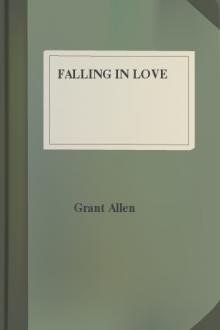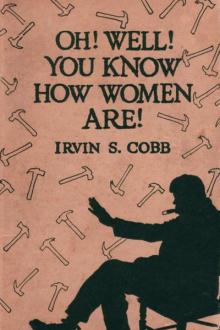Falling in Love by Grant Allen (different e readers .txt) 📕

- Author: Grant Allen
- Performer: -
Book online «Falling in Love by Grant Allen (different e readers .txt) 📕». Author Grant Allen
The grand conception of a gradual becoming, instead of a sudden making, which Kant and Laplace thus applied to the component bodies of the universe at large, was further applied by Lyell and his school to the outer crust of this one particular petty planet of ours. While the astronomers went in for the evolution of suns, stars, and worlds, Lyell and his geological brethren went in for the evolution of the earth's surface. As theirs was stellar, so his was mundane. If the world began by being a red-hot mass of planetary matter in a high state of internal excitement, boiling and dancing with the heat of its emotions, it gradually cooled down with age and experience, for growing old is growing cold, as every one of us in time, alas, discovers. As it passed from its fiery and volcanic youth to its staider and soberer middle age, a solid crust began to form in filmy fashion upon its cooling surface. The aqueous vapour that had floated at first as steam around its heated mass condensed with time into a wide ocean over the now hardened shell. Gradually this ocean shifted its bulk into two or three main bodies that sank into hollows of the viscid crust, the precursors of Atlantic, Pacific, and the Indian Seas. Wrinklings of the crust, produced by the cooling and consequent contraction, gave rise at first to baby mountain ranges, and afterwards to the earliest rough draughts of the still very vague and sketchy continents. The world grew daily more complex and more diverse; it progressed, in accordance with the Spencerian law, from the homogeneous to the heterogeneous, and so forth, as aforesaid, with delightful regularity.
At last, by long and graduated changes, seas and lands, peninsulas and islands, lakes and rivers, hills and mountains, were wrought out by internal or external energies on the crust thus generally fashioned. Evaporation from the oceans gave rise to clouds and rain and hailstorms; the water that fell upon the mountain tops cut out the valleys and river basins; rills gathered into brooks, brooks into streams, streams into primæval Niles, and Amazons, and Mississippis. Volcanic forces uplifted here an Alpine chain, or depressed there a deep-sea hollow. Sediment washed from the hills and plains, or formed from countless skeletons of marine creatures, gathered on the sinking bed of the ocean as soft ooze, or crumbling sand, or thick mud, or gravel and conglomerate. Now upheaved into an elevated table-land, now slowly carved again by rain and rill into valley and watershed, and now worn down once more into the mere degraded stump of a plateau, the crust underwent innumerable changes, but almost all of them exactly the same in kind, and mostly in degree, as those we still see at work imperceptibly in the world around us. Rain washing down the soil; weather crumbling the solid rock; waves dashing at the foot of the cliffs; rivers forming deltas at their barred mouths; shingle gathering on the low spits; floods sweeping before them the countryside; ice grinding ceaselessly at the mountain top; peat filling up the shallow lake—these are the chief factors which have gone to make the physical world as we now actually know it. Land and sea, coast and contour, hill and valley, dale and gorge, earth-sculpture generally—all are due to the ceaseless interaction of these separately small and unnoticeable causes, aided or retarded by the slow effects of elevation or depression from the earth's shrinkage towards its own centre. Geology, in short, has shown us that the world is what it is, not by virtue of a single sudden creative act, nor by virtue of successive terrible and recurrent cataclysms, but by virtue of the slow continuous action of causes still always equally operative.
Evolution in geology leads up naturally to evolution in the science of life. If the world itself grew, why not also the animals and plants that inhabit it? Already in the eager active eighteenth century this obvious idea had struck in the germ a large number of zoologists and botanists, and in the hands of Lamarck and Erasmus Darwin it took form as a distinct and elaborate system of organic evolution. Buffon had been the first to hint at the truth; but Buffon was an eminently respectable nobleman in the dubious days of the tottering monarchy, and he did not care personally for the Bastille, viewed as a place of permanent residence. In Louis Quinze's France, indeed, as things then went, a man who offended the orthodoxy of the Sorbonne was prone to find himself shortly ensconced in free quarters, and kept there for the term of his natural existence without expense to his heirs or executors. So Buffon did not venture to say outright that he thought all animals and plants were descended one from the other with slight modifications; that would have been wicked, and the Sorbonne would have proved its wickedness to him in a most conclusive fashion by promptly getting him imprisoned or silenced. It is so easy to confute your opponent when you are a hundred strong and he is one weak unit. Buffon merely said, therefore, that if we didn't know the contrary to be the case by sure warrant, we might easily have concluded (so fallible is our reason) that animals always varied slightly, and that such variations, indefinitely accumulated, would suffice to account for almost any amount of ultimate difference. A donkey might thus have grown into a horse, and a bird might have developed from a primitive lizard. Only we know it was quite otherwise! A quiet hint from Buffon was as good as a declaration from many less knowing or suggestive people. All over Europe, the wise took Buffon's hint for what he meant it; and the unwise blandly passed it by as a mere passing little foolish vagary of that great ironical writer and thinker.
Erasmus Darwin, the grandfather of his grandson, was no fool; on the contrary, he was the most far-sighted man of his day in England; he saw at once what Buffon was driving at; and he worked out 'Mr. Buffon's' half-concealed hint to all its natural and legitimate conclusions. The great Count was always plain Mr. Buffon to his English contemporary. Life, said Erasmus Darwin nearly a century since, began in very minute marine forms, which gradually acquired fresh powers and larger bodies, so as imperceptibly to transform themselves into different creatures. Man, he remarked, anticipating his descendant, takes rabbits or pigeons, and alters them almost to his own fancy, by immensely changing their shapes and colours. If man can make a pouter or a fantail out of the common runt, if he can produce a piebald lop-ear from the brown wild rabbit, if he can transform Dorkings into Black Spanish, why cannot Nature, with longer time to work in, and endless lives to try with, produce all the varieties of vertebrate animals out of one single common ancestor? It was a bold idea of the Lichfield doctor—bold, at least, for the times he lived in—when Sam Johnson was held a mighty sage, and physical speculation was regarded askance as having in it a dangerous touch of the devil. But the Darwins were always a bold folk, and had the courage of their opinions more than most men. So even in Lichfield, cathedral city as it was, and in the politely somnolent eighteenth century, Erasmus Darwin ventured to point out the probability that quadrupeds, birds, reptiles, and men were all mere divergent descendants of a single similar original form, and even that 'one and the same kind of living filament is, and has been, the cause of organic life.'
The eighteenth century laughed, of course. It always laughed at all reformers. It said Dr. Darwin was very clever, but really a most eccentric man. His 'Temple of Nature,' now, and his 'Botanic Garden,' were vastly fine and charming poems—those sweet lines, you know, about poor Eliza!—but his zoological theories were built of course upon a most absurd and uncertain foundation. In prose, no sensible person could ever take the doctor seriously. A freak of genius—nothing more; a mere desire to seem clever and singular. But what a Nemesis the whirligig of time has brought around with it! By a strange irony of fate, those admired verses are now almost entirely forgotten; poor Eliza has survived only as our awful example of artificial pathos; and the zoological heresies, at which the eighteenth century shrugged its fat shoulders and dimpled the corners of its ample mouth, have grown to be the chief cornerstone of all accepted modern zoological science.
In the first year of the present century, Lamarck followed Erasmus Darwin's lead with an open avowal that in his belief all animals and plants were really descended from one or a few common ancestors. He held that organisms were just as much the result of law, not of miraculous interposition, as suns and worlds and all the natural phenomena around us generally. He saw that what naturalists call a species differs from what naturalists call a variety, merely in the way of being a little more distinctly marked, a little less like its nearest congeners elsewhere. He recognised the perfect gradation of forms by which in many cases one species after another merges into the next on either side of it. He observed the analogy between the modifications induced by man and the modifications induced by nature. In fact, he was a thorough-going and convinced evolutionist, holding every salient opinion which Society still believes to have been due to the works of Charles Darwin. In one point only, a minor point to outsiders, though a point of cardinal importance to the inner brotherhood of evolutionism, he did not anticipate his more famous successor. He thought organic evolution was wholly due to the direct action of surrounding circumstances, to the intercrossing of existing forms, and above all to the actual efforts of animals themselves. In other words, he had not discovered natural selection, the cardinal idea of Charles Darwin's epoch-making book. For him, the giraffe had acquired its long neck by constant reaching up to the boughs of trees; the monkey had acquired its opposable thumb by constant grasping at the neighbouring branches; and the serpent had acquired its sinuous shape by constant wriggling through the grass of the meadows. Charles Darwin improved upon all that by his suggestive hint of survival of the fittest, and in so far, but in so far alone, he





Comments (0)